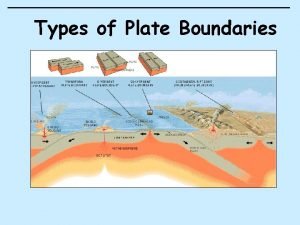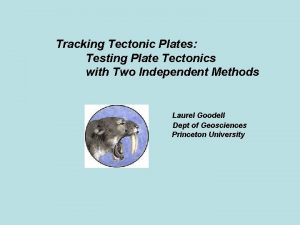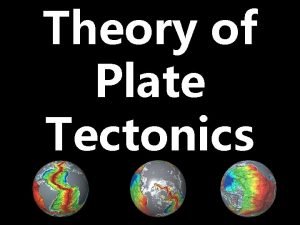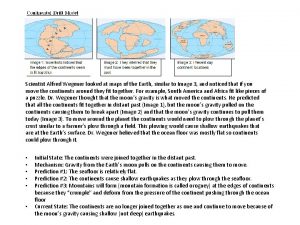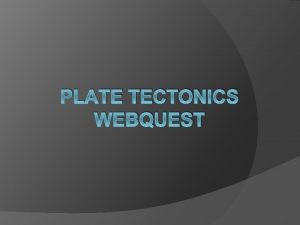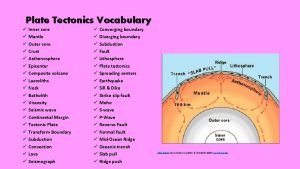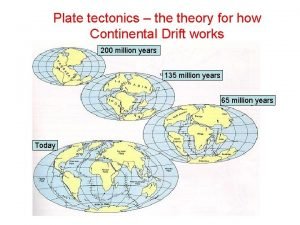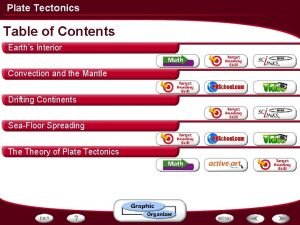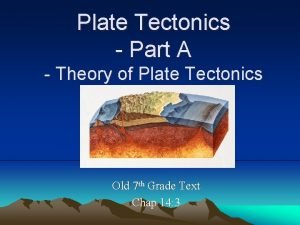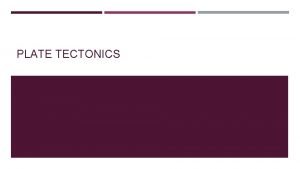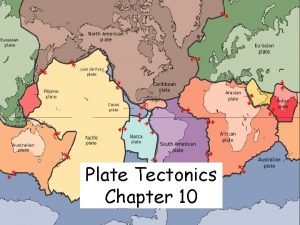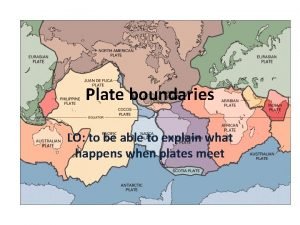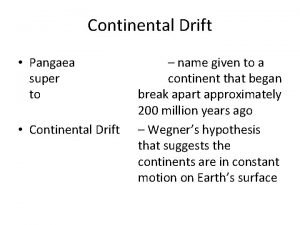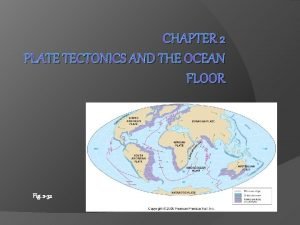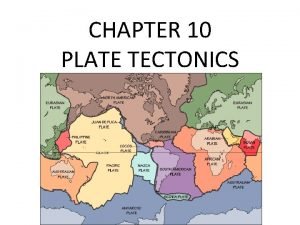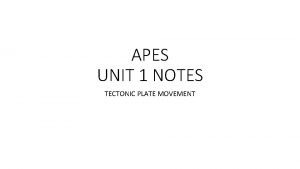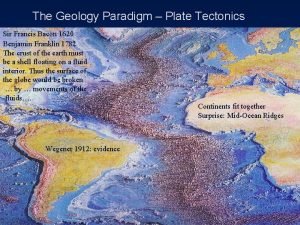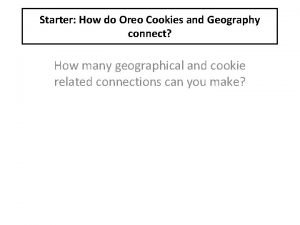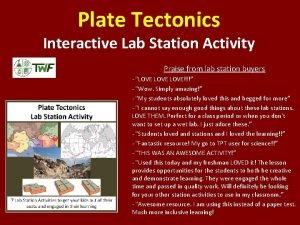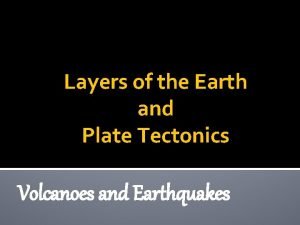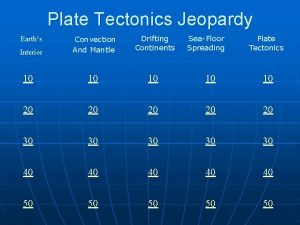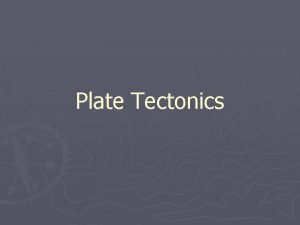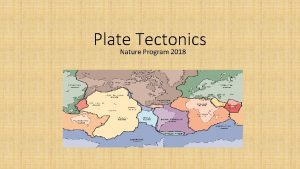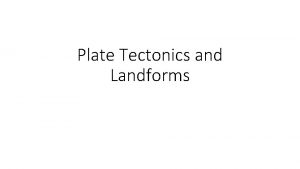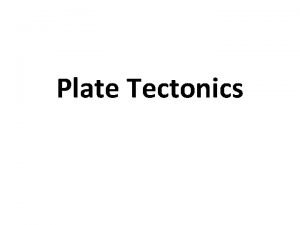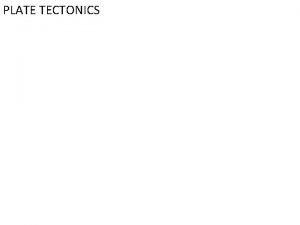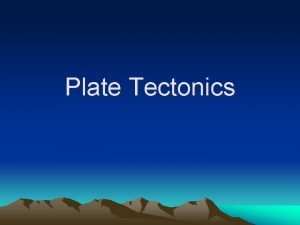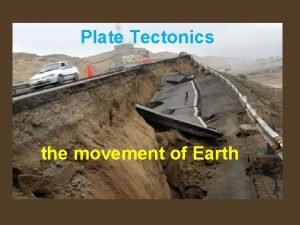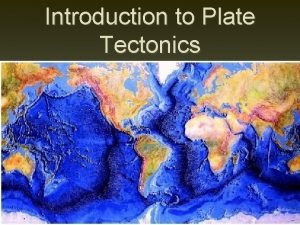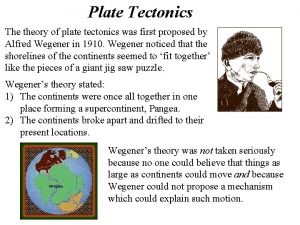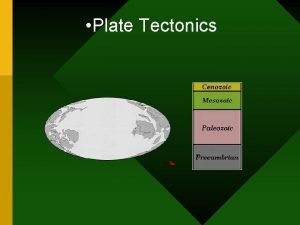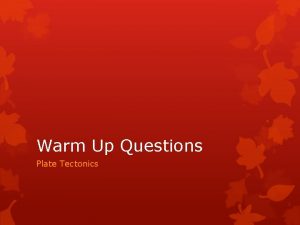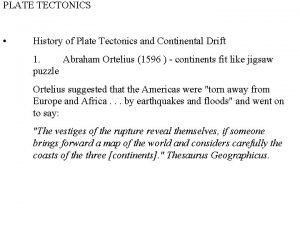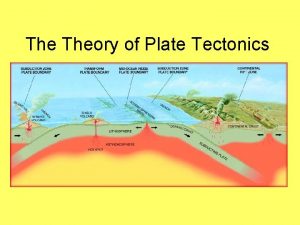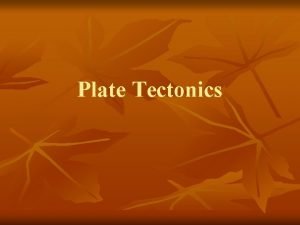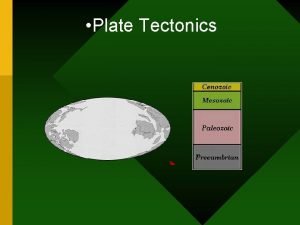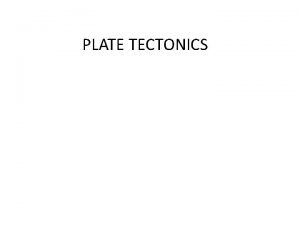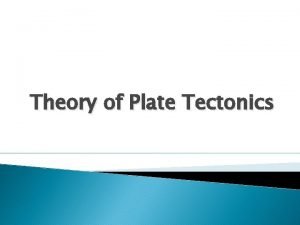To understand plate tectonics one must understand the






























- Slides: 30

To understand plate tectonics one must understand the dynamics between the solid, rigid lithosphere that is “floating” on a partially molten asthenosphere. The rigid lithosphere is composed of continental and ocean crust and the uppermost solid mantle. The plastic asthenosphere is composed of the upper mantle and is at or near the melting temperature for upper mantle rock.

The plate tectonic system is driven by convection within the asthenosphere. Convective upwelling, and partial melting of the asthenosphere, along divergent margins produces new ocean lithosphere, while it is subducted (consumed) along convergent margins.

The lithosphere is broken up into seven or eight major tectonic plates and several minor plates. Plate boundaries are defined by the relative motion between adjacent plates: divergent, convergent or transform.

Seismicity and plate tectonics. Note the relationship of depth of foci of earthquakes and tectonic plate boundary.

Relationship between active volcanism and tectonic plate boundaries.



The plate tectonic system is driven by convection within the asthenosphere. Convective upwelling, and partial melting of the asthenosphere, along divergent margins produces new ocean lithosphere, while it is subducted (consumed) along convergent margins.

Divergent margins first form under continental crust because of the insulating properties. When the continental crust is first heated at its base what will its topographic expression look like at the surface? Think of East Africa. Eventually, the upwelling basaltic magma will completely melt through the overlying continental crust and an incipient ocean basin will form and the two segments of continental crust will rift apart. Note that the ocean floor becomes wider as the new ocean lithosphere is produced at the devergent margin (referred to as sea floor spreading).

Basalt Flows The East African rift zone represents a continental rift. The topography of East Africa is highest in Africa because of heating the base of the continent by upwelling basaltic magma. The Red Sea is an incipient ocean basin. Note the dark basalt flows seen along the margins of the Red Sea in the above satellite image.

Midocean ridge spreading and volcanism in Heimey, Iceland.

We know that the Earth is not increasing in size due to the creation of new ocean lithosphere along seafloor spreading zones; thus it stands to reason that the ocean lithosphere must be consumed along convergent boundaries.

Ocean-Ocean lithosphere convergence (subduction). Examples: Japan and Phillipines Ocean-Continent lithosphere convergence (subduction). Examples: Andes Mountains and Cascade Mountains. Continent-Continent lithosphere collision (no subduction). Examples: Himalaya Mountains and European Alps.

Ocean-Ocean convergence. Formation of an island arc (Japan). What is the source of the rising magma (What components are partially melting)?

Ocean-Continental Convergence and formation of a continental volcanic arc. What is the source of magma produced along a continental arc? Is this consistent with the similar composition of volcanic rocks collected from Japan and the Cascades?

Cascade volcanoes related to subduction zone tectonics along the coastline of northern Californial to southern British Columbia.

What is the relationship between the depth of earthquake foci and the distance from the deep sea tranch along the subduction zone? Why do earthquakes cease at 600 km?

Continental collisions are preceded by ocean-continental convergence. As the continental lithosphere arrives at the subduction zone, it cannot be subducted because of its low density. The “collision” cause upwarping and deformation of the ocean floor and ocean lithosphere. Even segments of the upper mantle can be squeezed to the surface along the suture zone (where the two continents are stitched together).

The Indian tectonic plate collided with the Eurasian plate and caused the uplift of the Himalaya Mountains.

Transform boundaries typically form along mid-ocean rift zones, where the spreading rate differs and rigid crust is offset along the transform fault. Why do you think the earthquake foci are shallow along transform faults?

San Andreas Fault, California

Faults form where differential offset occurs between rigid rock or curst. Fault components are shown above. Note the difference between the focus and epicenter of a fault.

Energy is stored in the rock and then suddenly released when the stress exceeds the strength of the rock. When an earthquake occurs four different types of seismic waves are produced.

Seismic waves are energy waves that can move through the earth’s interior (Body Waves) or at the earth’s surface (surface waves). P- and S- waves are body waves and have higher frequencies and lower amplitudes than surface waves. P-waves have the highest velocities and are compression waves and particles move in the same direction as the wave. S-waves are shear waves and move particles up and down relative to wave direction. Surface waves are slowest of the seismic waves and have the largest amplitudes. Surface waves cause almost all the damage and destruction from earthquakes.

Differential P- and S- wave velocities coupled with differential arrival times at a given seismic station can be used to determine the distance from the seismic station to earthquake focus. Note the relationship between seismic wave amplitude and wave frequency. Wave amplitude and frequency are components of the total energy release.

Earthquake magnitude must be shown on a logrithmic scale. Each increase in magnitude equates to a ~30 -fold increase in total energy release.

The focus (and epicenter) can be located by triangulation using three different seismograph stations.

Seismic waves are generated naturally by earthquakes and anthropogenically by detonation of nuclear bombs or other explosives below the ground surface, Note the absence of S-waves emitted from the nuclear bomb detonation. .

Seismic risk in the United States (%g) acceleration due to force of gravity due to ground shaking. What is the relationship between seismic risk and tectonic setting in the United States?

Estimated fatalities from the 10 deadliest earthquakes in history. 1. Shensi, China. Jan. 23, 1556. Magnitude 8 – 830, 000 fatalities. 1. Tangshan, China. July 27, 1976. Magnitude 7. 5 – 655, 000 fatalities. 1. Aleppo, Syria. Aug. 9, 1130. Magnitude ? – 230, 000 fatalities. 1. Sumatra, Indonesia. Dec. 26, 2004. Magnitude 9. 1 – 227, 898 fatalities. 1. Haiti, Jan. 12, 2010. Magnitude 7. 0 – 222, 570 fatalities. 1. Damghan, Iran. Dec. 22, 856. Magnitude ? - ~200, 000 fatalities. 1. Haiyuan, Ningxia, China. Dec. 16, 1920. Magnitude 7. 8 - ~200, 000 fatalities. • Ardabil, Iran. March 23, 893. Magnitude ? - ~150, 000 fatalities. 1. Kanto, Japan. Sept. 1, 1923. Magnitude 7. 9 – 142, 000 fatalities. 1. Ashgabat, Turkmenistan. Oct. 5, 1948. Magnitude 7. 3 – 110, 000 fatalities.
 To understand recursion you must understand recursion
To understand recursion you must understand recursion Plate tectonics vs continental drift
Plate tectonics vs continental drift What are four types of plate boundaries?
What are four types of plate boundaries? Evidence of the theory of plate tectonics
Evidence of the theory of plate tectonics Plate tectonics theory states that
Plate tectonics theory states that Plate tectonics vs continental drift
Plate tectonics vs continental drift Compare continental drift and plate tectonics
Compare continental drift and plate tectonics Plate tectonics webquest answer
Plate tectonics webquest answer Inner core vocabulary
Inner core vocabulary Continental drift vs plate tectonics theory
Continental drift vs plate tectonics theory Plate tectonics
Plate tectonics Plate tectonics definition
Plate tectonics definition Driving force of plate tectonics
Driving force of plate tectonics What is this process called
What is this process called Summarize the theory of plate tectonics
Summarize the theory of plate tectonics Arthur holmes contribution to plate tectonics
Arthur holmes contribution to plate tectonics Continental drift vs plate tectonics
Continental drift vs plate tectonics Mantle magma
Mantle magma Types of plate boundaries
Types of plate boundaries Edible tectonic plates
Edible tectonic plates A plate tectonics puzzle worksheet answer key
A plate tectonics puzzle worksheet answer key From now
From now Fossils as evidence of continental drift
Fossils as evidence of continental drift Apes frq plate tectonics
Apes frq plate tectonics Francis bacon plate tectonics
Francis bacon plate tectonics Oreo cookies and plate tectonics answer key
Oreo cookies and plate tectonics answer key Plate tectonics interactive lab
Plate tectonics interactive lab Divergent boundary oreo
Divergent boundary oreo Oreo plate tectonics
Oreo plate tectonics Types of volcanoes
Types of volcanoes Plate tectonics game board
Plate tectonics game board


